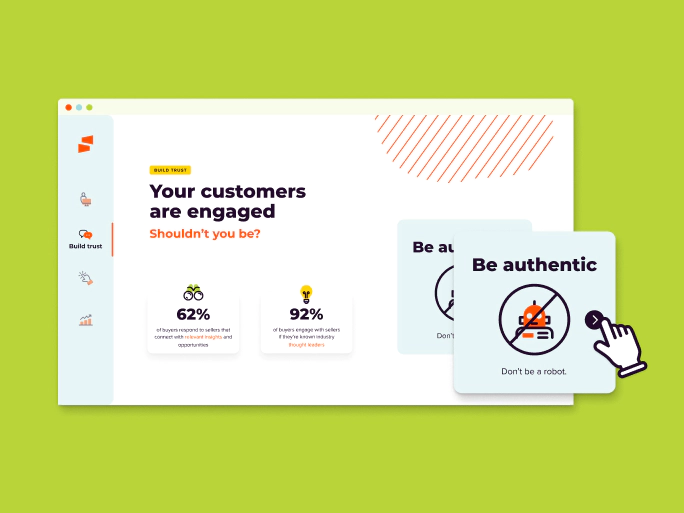The growth of digital channels and evolving buyer behaviour are fundamentally changing the sales landscape. Today, prospects are increasingly researching businesses before engaging with salespeople, with digital channels serving as their primary mode of communication. Traditional outbound tactics, like cold calls, are losing effectiveness, with studies showing that 90% of C-suite executives ignore them.
Meanwhile, social media holds significant sway, influencing 75% of B2B buyers during the purchasing journey. With billions of users on platforms like LinkedIn – including your target audience and employees – social media presents a powerful opportunity for engagement.
With more than 900 million users on LinkedIn, there’s a strong chance that your audience is active on social media. And so are your employees. In this social selling guide, we’ll show you how to sell on social media, share best practices, and offer tips for how your business can stand out in a highly competitive digital marketplace.
Did you know?
75%
of B2B buyers are influenced by social media during the buyer’s journey.
What is social selling?
Social selling is leverages social media activity and engagement as a central part of the sales process. Selling with social media embraces two-way communication to build and nurture relationships that may eventually turn into business opportunities.
Social selling isn’t about selling in the traditional sense. Instead, social selling activities are less transactional and driven more by building authentic relationships. When done well, social selling can lead to sales, but that isn’t the point. Instead, social media gives sellers a platform to enhance existing relationships, nurture new ones, and build trust at scale.
Social selling isn’t the content shared from a branded corporate account. It isn’t individual users repurposing said branded content from a corporate account to share with their network. Instead, social selling is a soft skill that asks sellers to build their brand by interacting with their network, engaging with content shared by others, participating in organic conversations, and sharing timely, relevant third-party content.
The path to success in social selling starts with setting the right expectations. The first rule of social selling is that it isn’t about selling in the first place. It’s about building relationships and enabling trust at scale. With that in mind, a successful social selling strategy is built on authenticity. Equipping your employees with a platform that allows them to post content that aligns with their interests, opens a gateway to building new relationships. And over time, these relationships can mature into opportunities and, eventually, customers.
Think of social selling as if it were a networking event. The event is crowded and there are countless opportunities to make new connections and take part in conversations with like-minded individuals. Social selling is an opportunity to take part in an interesting conversation where believe you can bring value. The approach is no different on social media platforms. If someone shares interesting content, let them know that you’re interested with a comment or reaction.
What are the benefits of social selling?
Businesses compete to gain customer attention, and social selling is an additional tool for organisations to break through the noise. Customer engagement on social media generates actionable insights that help sales and marketing professionals optimise the way they communicate with their audiences and ideal prospects. Engaging with new connections on social media offers insight into what a lead is interested in and, when used effectively, this information can lead to stronger relationships.
With fewer buyers responding to cold calls, social media offers an opportunity to connect in a meaningful way. Social selling holds a significant advantage over traditional outbound tactics in that it enables a less-intrusive approach to communicating with prospects. More buyers are embracing social media in the buyer’s journey. Most customers want to be in control of the buying process, with B2B buyers reading 13 pieces of content before speaking with a sales representative. Instead of interrupting with a phone call, customer engagement on social media allows sales professionals to engage with content or a message that buyers can interact with on their own terms.
The true power of social selling is that it allows your team to cast a wider net. For example, if a business development manager (BDM) spends seven hours cold calling and schedules a second call with two prospects, is that time well spent? If, on the other hand, a seller leverages social selling on LinkedIn to share useful content with their network of 1,000 users, that content isn’t limited to their direct network. Compelling content gets shared and ultimately extends the reach of your communication beyond traditional methods. So, in the long run, dedicating an hour each day to customer engagement on LinkedIn or your social platform of choice can go a long way.
Drive Seller Success through Social

The importance of a social selling tool
To scale your social selling programme in a way that keeps employees aligned on key messages and best practices, you need a dedicated social selling tool. Social selling tools allow users to easily find and share highly relevant content that educates buyers and sparks conversations.
Here are five different components of a social selling tool that can be helpful for a B2B sales manager:
1. Content curation: The ability to curate relevant content empowers them to share high-quality content with their network.
2. Analytics and measurement: Analytics and measurement capabilities allow sellers to track their social selling efforts and connect them to revenue generation.
3. Ease of use: Sellers can effortlessly search for content and share it with their network in a just a few clicks.
4. Audience understanding: Insights into the target audience’s needs and preferences help sellers tailor their social selling posts so they resonate with readers.
5. Compliance and industry regulation: With compliance features, social selling tools guarantee that shared content adheres to industry regulations and organisational policies regarding confidentiality and privacy. AI-based compliance platforms also review content at scale, ensuring that the content shared by advocates adheres to company and industry standards
By harnessing the power of social selling tools, businesses can elevate their sales effectiveness, enhance their brand reputation, and drive sustainable growth in today’s competitive marketplace.
Ready to win on social?
Social selling best practices
Launching a social selling programme in your organisation requires a well-crafted plan, dedication, and collaboration from many different teams. Here are five tips for social selling success.
1
Define your strategy
2
Set expectations and goals
3
Align with compliance and legal departments
4
Provide social selling training
5
Develop a content strategy
Harness the power of social with Seismic LiveSocial
Seismic LiveSocial is a social selling platform that makes it easy to activate sellers on social channels and builds trust and relationships at scale. The platform enables customer engagement through a continuously updated library of credible, high-quality, third-party content for sales and marketing professionals. Seismic LiveSocial uses artificial intelligence (AI) to curate relevant content for each individual seller and allows them to share, measure, and connect their efforts to revenue generation. Get a demo to learn more, or watch this on-demand video.

